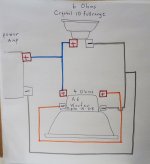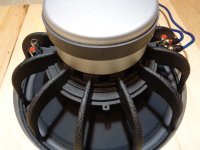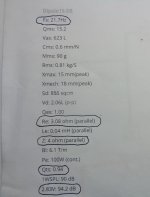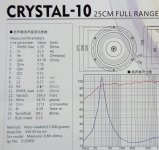Sorry. Work and some family issues came up. Plus I'm still waiting on the woofers to arrive. Hopefully they'll be here by Saturday. Thanks Pano for the detailed report and the simulations. I really do appreciate it! And hopefully next week I'll be full swing into working on the crossovers. OR should I let the woofers burn in first? I know the full range drivers have evolved over the last 150 hours and are now more extended.
In my reading, I came across the issue of wide vs narrow baffles. Someone said the reason narrow baffles are most often used is because of women/WAF or aesthetics. Before mounting my woofers (yes, they came today!) I'd like opinions on whether placing them with the baffles 24 inches wide or 36 inches wide would "sound" best and why? I know Pano said it didn't matter much so mount them in the center and keep them near the full range driver. But that was when I said I was going to place the baffle 24 inches wide and 36 inches high. I'm open to recommendations.
Leon Huigen, the man behind the Leonidas crossover for the Pure Audio Project speaker has published a design for the drivers that you intend to use. It can be found at
Audio Dandy - How to enjoy High Resolution Audio
Audio Dandy - How to enjoy High Resolution Audio
Thanks ponger. There's some similarity. I see Leon's speakers use a tweeter, I don't. And the woofer is 8 Ohms (mine is 4). Problem. My amp is 250 watts @ 8 Ohms and 400 watts @ 4 Ohms. My woofers are 4 Ohms and my full ranges are 6 Ohms. I'm so new to all this I've just discovered my speakers paralleled = 2.4 Ohms and in series = 10 Ohms (outside my amps range). I read somewhere the finished speaker Ohms would be whatever your woofer's Ohms were. That made me think my driver combo would be okay but I guess that was false information. Will my amp constantly short out or get fried? 🙁 I really don't have $$$ to drop on a new amp right now or in the future. Anything I can do to make it all work safely?
Last edited:
Wide vs Narrow will be a debate for as long as we build Open Baffle. 😉 I like the wider baffle because it helps lower the frequency at which the bass cancels out, and bigger baffles tend to sound more dynamic. That might be because the are more efficient than smaller baffles.
Placement of the woofer will affect the response, putting it right in the center is usually not a good idea a it tends to exaggerate the baffle peak. That's easily overcome by simply placing the woofer high or low on the baffle.
Placement of the woofer will affect the response, putting it right in the center is usually not a good idea a it tends to exaggerate the baffle peak. That's easily overcome by simply placing the woofer high or low on the baffle.
The Lii W15 is a dual voice coil 8 ohm driver. Run in parallel, it would be 4 ohm. The tweeter is optional. The only variable would be the efficiency of the drivers which could be adjusted by the resistor.
Narrow baffle means the edge diffractions are less noticeable. Mounting off centre varies the distances to the edges more and smooths out the on axis response more. Another option is an L-frame What is the polar response of "L-frame" OB speakers I'm still waiting for Danny Richie to get back with the polar response measurements of his speakers.In my reading, I came across the issue of wide vs narrow baffles. Someone said the reason narrow baffles are most often used is because of women/WAF or aesthetics. Before mounting my woofers (yes, they came today!) I'd like opinions on whether placing them with the baffles 24 inches wide or 36 inches wide would "sound" best and why? I know Pano said it didn't matter much so mount them in the center and keep them near the full range driver. But that was when I said I was going to place the baffle 24 inches wide and 36 inches high. I'm open to recommendations.
I've set my drivers to run in series which gives me 10 Ohms (safe for my amp). I've also been following the Introduction to designing crossovers without measurement. Measurements for the woofers are given in parallel (Re=3.08 and Le=0.04 mH). Do the values change since I'm running them in series? If yes, How do I figure out the Re and Le measurements with the drivers running in series so as to accurately figure out the values for resistors and capacitors I'll be using in the crossover?
If you're running 2 voice coils in series, they become 16 ohms. You also have to decide what slope you will be crossing at as well as the frequency.
Now I'm confused. My woofer has 2 sets of voice coil connectors, but I only connected one set because I'm not sure how to wire both with my full range driver.
I plan to crossover at around 450 Hz.
Not sure about the slope, Introduction to designing crossovers without measurement hasn't covered this using the specific word "slopes." But they recommend a capacitor, resistor and inductor for both drivers (so that would be a 3rd order at 18 dB/octave slope)?
I plan to crossover at around 450 Hz.
Not sure about the slope, Introduction to designing crossovers without measurement hasn't covered this using the specific word "slopes." But they recommend a capacitor, resistor and inductor for both drivers (so that would be a 3rd order at 18 dB/octave slope)?
If you wire your woofers in series to make 16 ohms, you will need higher voltage out of your amp to get a certain SPL. You will also need a much bigger value inductor for the low pass filter.
This calculator should help you understand the basics.
2-Way Crossover Calculator / Designer
This calculator should help you understand the basics.
2-Way Crossover Calculator / Designer
My woofers are 4 Ohms and the full range drivers are 6 Ohms. I arrive at a total of 10 Ohms using this calculator
https://geoffthegreygeek.com/speakers-in-series-calculator/
Please explain how you arrive @ 16 Ohms.
https://geoffthegreygeek.com/speakers-in-series-calculator/
Please explain how you arrive @ 16 Ohms.
4 ohms and 6 ohms in series=10 ohms. Rtotal=R1+R2
4 ohms and 6 ohms i parallel= 2.4 ohms. Rtotal=1/(1/R1+1/R2)
4 ohms and 6 ohms i parallel= 2.4 ohms. Rtotal=1/(1/R1+1/R2)
Last edited:
If your woofers are dual voice coil, and you are only using 1 4 ohm voice coil, you could wire the 2 voice coils together in parallel to make 2 ohms, or in series to make 8 ohms. If you use only one, I believe it would cut your power in half.
You have to watch 18db crossovers. The phase becomes tricky.
You have to watch 18db crossovers. The phase becomes tricky.
Sorry, my mistake. I was thinking dual 8 ohm coils in the woofers, I don't know why. 
When you use a passive crossover, the part of the spectrum attenuated by the crossover becomes very high impedance, that's how crossovers work. So you don't have to worry about the combined load of the woofer and tweeter. Unless you overlap the two bands, which you would not be doing.

When you use a passive crossover, the part of the spectrum attenuated by the crossover becomes very high impedance, that's how crossovers work. So you don't have to worry about the combined load of the woofer and tweeter. Unless you overlap the two bands, which you would not be doing.
Aren't the woofers the Acoustic Elegance Dipole15 - D8 each having 2 voice coils of 8 ohms ?
In parallel the impedance is 4 ohms, in series the impedance would be 16 ohms.
Once filter networks are introduced the overall system impedance can vary to quite a low value, it depends on the final overall woofer's impedance that 's chosen. 4 ohms might be a bit low, using just one 8 ohm voice coil of the woofer (with the resultant loss -3db) might be a better choice.
Actually the Acoustic Elegance Dipole15 - D16 might have been the better option when ordering.
C.M
In parallel the impedance is 4 ohms, in series the impedance would be 16 ohms.
Once filter networks are introduced the overall system impedance can vary to quite a low value, it depends on the final overall woofer's impedance that 's chosen. 4 ohms might be a bit low, using just one 8 ohm voice coil of the woofer (with the resultant loss -3db) might be a better choice.
Actually the Acoustic Elegance Dipole15 - D16 might have been the better option when ordering.
C.M
Pano you said
"Sorry, my mistake. I was thinking dual 8 ohm coils in the woofers, I don't know why."
It was because that's what I said before the woofers arrived. So I'm the one needs to say "sorry."
Ponger suggests series wiring. Would that look something like this?

Here's a close-up of one of the AE woofers.

Tweet says they're 8 Ohms if wired in series. That would give me a 22 Ohm load. Speakers in Series Calculator - Geoff the Grey Geek says my amp can handle it. But Tweet (and the spec sheet) says they're 4 Ohms if wired parallel and that would give me a 1.5 Ohm load which would be very bad for my amp.
Is my understanding correct?
"Sorry, my mistake. I was thinking dual 8 ohm coils in the woofers, I don't know why."
It was because that's what I said before the woofers arrived. So I'm the one needs to say "sorry."
Ponger suggests series wiring. Would that look something like this?

Here's a close-up of one of the AE woofers.

Tweet says they're 8 Ohms if wired in series. That would give me a 22 Ohm load. Speakers in Series Calculator - Geoff the Grey Geek says my amp can handle it. But Tweet (and the spec sheet) says they're 4 Ohms if wired parallel and that would give me a 1.5 Ohm load which would be very bad for my amp.
Is my understanding correct?
Last edited:
You should not be wiring them together without a crossover. At least not if you want them to sound good. But if you want to try it, just wire the dual coils in series to get 8 ohms. The impedance of the woofers is going to be rising anyway, so it's not 8 ohms all the way up. If the fullrange are 8 ohms you'll not be going under 4 ohms anyway.
No, the woofer's impedance would be 16 ohms if its voice coils are wired in series.
If the woofer's voice coils are wired in parallel the resulting impedance will be 4 ohms.
If you then wire the 10" Fulrange voice coil (6 ohm impedance) in series with the 4 ohm impedance of the woofer you would then have an overall impedance of 10 ohms.
But that's not a smart way of doing things as you would have to design a series crossover to work with that combination. A series crossover is not the easiest to work with and to pull it off. A parallel network is a better approach, where the woofer is wired through its own crossover in parallel with the fulrange and its network.
It would be better just to wire one 8 ohm voice coil of the woofer and leave the other 8ohm voice coil unconnected. This would give an 8 ohm impedance for the woofer to work with rather than 4 ohms which could possibly endanger your amplifier's output stage.
A driver's (Re) voice coil DC resistance is lower than that of its impedance and that can load the amplifier quite heavily over a limited bandwidth. That is why it is better to use a higher impedance driver with its higher (Re) voice coil than a lower impedance driver. The associated crossover if not properly designed can cause the impedance to drop very low so padding out with some series resistance at the input of the crossover will help protect your amplifier.
So aim for a parallel crossover network with some series resistance to keep the impedance up from getting too low for your amplifier.
C.M
If the woofer's voice coils are wired in parallel the resulting impedance will be 4 ohms.
If you then wire the 10" Fulrange voice coil (6 ohm impedance) in series with the 4 ohm impedance of the woofer you would then have an overall impedance of 10 ohms.
But that's not a smart way of doing things as you would have to design a series crossover to work with that combination. A series crossover is not the easiest to work with and to pull it off. A parallel network is a better approach, where the woofer is wired through its own crossover in parallel with the fulrange and its network.
It would be better just to wire one 8 ohm voice coil of the woofer and leave the other 8ohm voice coil unconnected. This would give an 8 ohm impedance for the woofer to work with rather than 4 ohms which could possibly endanger your amplifier's output stage.
A driver's (Re) voice coil DC resistance is lower than that of its impedance and that can load the amplifier quite heavily over a limited bandwidth. That is why it is better to use a higher impedance driver with its higher (Re) voice coil than a lower impedance driver. The associated crossover if not properly designed can cause the impedance to drop very low so padding out with some series resistance at the input of the crossover will help protect your amplifier.
So aim for a parallel crossover network with some series resistance to keep the impedance up from getting too low for your amplifier.
C.M
Last edited:
No drivers are wired together yet. But the info is conflicting. Here's the woofer's specs:

So I'm thinking the voice coils are 4 Ohms each, not 8. If I wire a woofer in parallel won't it turn to 2 Ohms?
Here are the specs for the full range:
 =
=
If I wire the 6 Ohm full range in parallel with the woofer wouldn't it drop below 2 Ohms? My amp can't do anything less than 4 Ohms.

So I'm thinking the voice coils are 4 Ohms each, not 8. If I wire a woofer in parallel won't it turn to 2 Ohms?
Here are the specs for the full range:
 =
=If I wire the 6 Ohm full range in parallel with the woofer wouldn't it drop below 2 Ohms? My amp can't do anything less than 4 Ohms.
Last edited:
- Home
- Loudspeakers
- Multi-Way
- Need construction advice for OB